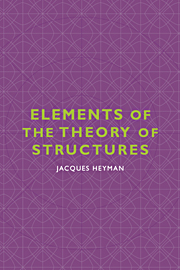Book contents
- Frontmatter
- Contents
- Preface
- 1 The theory of structures
- 2 Virtual work
- 3 Betti, Maxwell, Müller-Breslau, Melchers
- 4 Jettied construction
- 5 Clebsch, Macaulay, Wittrick, Lowe
- 6 The elastica
- 7 Mechanisms of collapse
- 8 The absolute minimum-weight design of frames
- 9 Inverse design of grillages
- 10 The relation between incremental and static plastic collapse
- 11 The bending of a beam of trapezoidal cross-section
- 12 The simple plastic bending of beams
- 13 Leaning walls; domes and fan vaults; the error function ∫e−t2dt
- Bibliography
- Name index
- Subject index
11 - The bending of a beam of trapezoidal cross-section
Published online by Cambridge University Press: 18 December 2009
- Frontmatter
- Contents
- Preface
- 1 The theory of structures
- 2 Virtual work
- 3 Betti, Maxwell, Müller-Breslau, Melchers
- 4 Jettied construction
- 5 Clebsch, Macaulay, Wittrick, Lowe
- 6 The elastica
- 7 Mechanisms of collapse
- 8 The absolute minimum-weight design of frames
- 9 Inverse design of grillages
- 10 The relation between incremental and static plastic collapse
- 11 The bending of a beam of trapezoidal cross-section
- 12 The simple plastic bending of beams
- 13 Leaning walls; domes and fan vaults; the error function ∫e−t2dt
- Bibliography
- Name index
- Subject index
Summary
Section 7 of Tredgold's Practical essay on the strength of cast iron (1824) deals with the strength and deflexion of cast iron when it resists pressure or weight – that is, it deals with the elastic bending of beams. In the 1822 edition Tredgold considered only beams of cross-section having two axes of symmetry, but in the second edition of 1824 he added a paragraph (85a) – together with a footnote – which investigates a problem of bending with only one axis of symmetry:
85a. Hitherto we have only considered those forms where the neutral axis divides the section into identical figures; but there are some interesting casesa where this does not happen, such, for example, as the triangular section.
a (They are interesting, because the earlier theorists fell into some serious errors respecting them, and consequently have led practical engineers into erroneous opinions.)
The triangular section considered by Tredgold is shown in fig. 11.1, with part of the triangle cut off at the vertex; this is a general case which will include that of the entire triangle (i.e. m = 0). Tredgold's immediate problem is to locate the neutral axis MN, and he does not have Navier's formal statement of 1826 that the neutral axis must pass through the centre of gravity of the cross-section.
Navier (1826) was in fact the first to make this statement, but the result is implicit in earlier work, for example that of Parent (1713) and of Coulomb (1773).
- Type
- Chapter
- Information
- Elements of the Theory of Structures , pp. 103 - 106Publisher: Cambridge University PressPrint publication year: 1996



